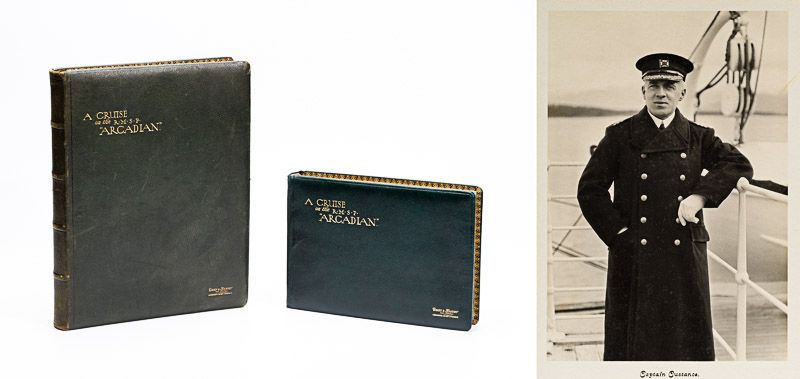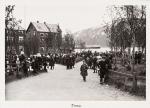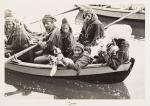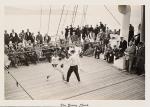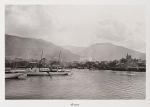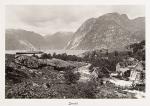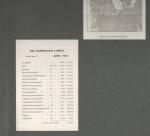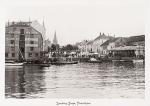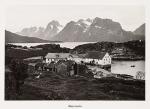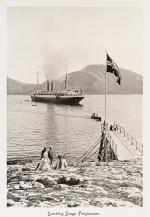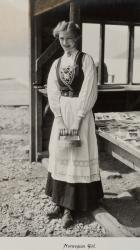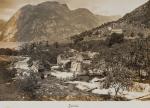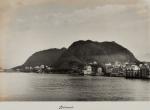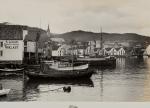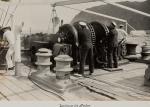[Davey & Hackney, R.M.S.P. Arcadian. Two Vintage Photo Albums
Two Vintage Photo Albums / Portfolios of “Cruise No. 2 to ‘The Norwegian Fjords’ in June 1913 on the R.M.S.P. Arcadian”. Fantastic combination of two photo logbooks of one of the last trips for this beautiful passenger liner before she served with the Royal Navy and was sunk by a U-boat, the German submarine SM UC-74, in 1917. These luxury photographic records were created by Davey & Hackney, Alexandra Palace, London. I. Album One: On 24 pages (12 stiff cardboards with photographs on both sides) with 44 vintage high-quality photographs, the cruise was documented by not only focusing on the natural beauty of Norway but also by documenting the captain (Captain Custance) and crew of the Arcadian, one large photograph shows the captain and all his officers. Some striking images of the ship itself are showing this liner in all its glory. The ship was built in 1899 by Vickers, Sons & Maxim Ltd. for the Pacific Steam Navigation Company as SS Ortona. This unusually luxury Album also documents in an appendix with a small map of Norway the Itinerary of the cruise. All mileage covered and dates the cruise would reach the scheduled destinations in Norway are mentioned (Grimsby, Wed. 18 June / Leith, 235 miles, Thursday 19 June / Aalesund 493 Miles Sat. 21 June / and so on and so on). The cruise would stop at Molde (Moldefjord), Aandalsnaes (Romsdalfjord) / Oie (Jorundfjord) / Hellesylt (Sunelvsfjord) / Merok (Geirangerfjord) / Olden (Invikfjord) / Loen (Nordfjord) / Mundal (Fjaerlandsfjord) / Balholmen (Sognefjord) / Gudvangen (Naerofjord) / Sundal (Maurangerfjord) / Norheimsund (Hardangerfjord) / Bergen / back to Grimsby on July 2nd, 1913 with a total of 2127 miles covered in 14 days. The photographs of the “Arcadian” are differing in size from a beautiful full ship image in 17.5 cm x 28.7 cm to detailed photographs of the deck in 11.5 cm x 16.4 cm; a nice photo of the “Arcadian’s” Launch (with small steem funnel), interior of the ship (Dining Salon), a photograph of a visiting steam Tender (″The Grimsby Tender”), Deck tennis – scenes, Playing Bull Board, Letting go the Anchor with two crew members. / II. Album Two: This additional, smaller Album, on an additional 24 pages (12 stiff cardboards with photographs on both sides) shows a further 24 vintage, high-quality photographs. These additional photographs show The Hardangerfjord / Folgefond Glacier / An Arcade in the Dining Salon / Photograph of Captain Custance / Sundal / The Landing Stage in Norheimsund / Fysse / The Landing Stage in Trondheim with many locals waiting / The Landing Stage in Forhatten / Digermulen / The Raftsund Fjord / Lyngenfjord / A boat full of Lapps in traditional clothing, showing and offering livestock and handmade dolls for tourists on board the “Arcadian” / Hammerfest / North Cape & Midnight Sun from the “Arcadian” / Tromso, with a large gathering of schoolchildren / A Boxing Match on the “Arcadian”, showing two pugilists fighting it out to the bemusement of bystanders / Pillow Fighting as Pastime for Tourists on the “Arcadian” / Molde from the Hill, showing the “Arcadian” in the Fjord / Aandalsnes / View from Aandalsnes / Bergen and Bergen Harbour with a few nice local Yachts in the foreground // The quality of the photography in both of these Album is excellent.
London / Norway, Davey & Hackney Photo (Alexandra Palace), 1913. Sizes: Vol. I: Folio (25.5 cm x 32 cm) / Vol.II: Oblong Octavo (25 cm x 17 cm). Volume I: 12 cardboard sheets with 24 pages (of which 24 are with photographs) with foldable appendix / Volume II: 12 cardboard sheets with 24 pages (of which 24 are with photographs) Hardcover / Green soft morocco with gilt lettering on cover and ornament around the pastedowns of the inner boards. Some minor rubbing to the binding but overall in excellent, near Fine condition with only minor signs of external wear.
Includes for example the following titled photographs: Moldefjord, Pulpit Rock, Merck, Merok, Seven Sisters Waterfall, Hellesylt, Loen Lake, Balhomen, Norwegian Corn Field, Mundal, Fancy Dress Ball, June 26th 1913, Naerofjord, Norwegian Girl, Folgefond Glacier, Norwegian Pony, Sundal, Fysse, Bergen, Norwegian Boats etc.
SS Arcadian was a Barrow-in-Furness built passenger liner constructed in 1899 by Vickers, Sons & Maxim Ltd for the Pacific Steam Navigation Company as SS Ortona. In World War I she served with the Royal Navy and was sunk by a U-boat in 1917.
SS Ortona was the last ship that Pacific Steam built for the London-to-Australia route. Launched on 10 July 1899 and registered in Liverpool on 26 October, she left London on her maiden voyage was on 24 November in a joint service with the Orient Steam Navigation Company. She carried 140 first-class, 180 second-class and 300 third-class passengers, a total of 620. In December 1902, Ortona was used to return troops to the UK after the end of the Second Boer War.
On 8 May 1906 Ortona was sold to the Royal Mail Steam Packet Company, who used her in a joint operation with the Orient line to Australia. The “All Golds” professional New Zealand Rugby League team, travelled on Ortona from Australia to France via Ceylon in August/September 1907. In April 1909, she was transferred to the Royal Mail West Indies service. In 1910, she was sent to the Harland & Wolff shipyard in Belfast for conversion into a 320-capacity cruise ship with a new gross tonnage of 8,939. She was renamed RMS Arcadian on 21 September 1910 as the RMSP’s liners had names beginning with the letter “A”, and was registered at Belfast in September of the following year. She started her first world cruise in January 1912, the largest dedicated cruise ship in the world at that time. She was on the first leg of this voyage that Olave St Claire Soames met Lieutenant General Sir Robert Baden-Powell, the founder of the Scout Movement, leading to their marriage in October of that year.
In February 1915, near the start of the First World War, Arcadian was taken up by the Admiralty and converted to an armed merchant cruiser. On 7 April 1915 at Alexandria, General Sir Ian Hamilton came aboard and used Arcadian, together with the battleship Queen Elizabeth, as his headquarters ship during the opening phase of the Gallipoli Campaign. Once Hamilton’s staff had transferred to a shore base at Imbros, Arcadian was employed as a troop ship in the Mediterranean.
On 15 April 1917 Arcadian was en route from Thessaloniki (Salonika) to Alexandria with a company of 1,335 troops and crew and escorted by a Japanese Navy destroyer. Shortly after completing a boat drill, while 26 miles north east of the Greek island of Milos, Arcadian was hit by a single torpedo from the German submarine SM UC-74 and sank within six minutes with the loss of 279 lives. A contemporary newspaper article described how four of Arcadian’s overcrowded lifeboats were successfully lowered before she sank. Some of the dead were cooks and stokers who were working below decks. The escorting destroyer had two torpedoes launched at her while she was attempting to rescue men from the water; survivors reported that she had lowered three of her own boats while going “at full speed”. More survivors, who had been clinging to a raft, were rescued at midnight by the Q-ship HMS Redbreast. Among the dead was the eminent bacteriologist, Sir Marc Armand Ruffer, who was returning to Alexandria after advising on the control of an epidemic among troops based at Thessaloniki. (Wikipedia)
- Keywords: 20th Century – Rare · Catalogue Six – Photography · Catalogue Summer 2020 · Cruise Liner · Inanna Modern – Photography Books · Maritime History – Rare · Norway · Norwegen · Photograph · Photographie · Photographs · Photography · Photography – Rare · R.M.S.P. Arcadian · SS Ortona · Travel & Expedition – Rare · Travel Scandinavia – Rare · Vintage Photoalbum · Vintage Photograph · Vintage Photographs · Vintage Photographs 20th century · West Cork Rare Book Fair 2022
- Language: English
- Inventory Number: 110204AB
EUR 2.200,--
© 2025 Inanna Rare Books Ltd. | Powered by HESCOM-Software



